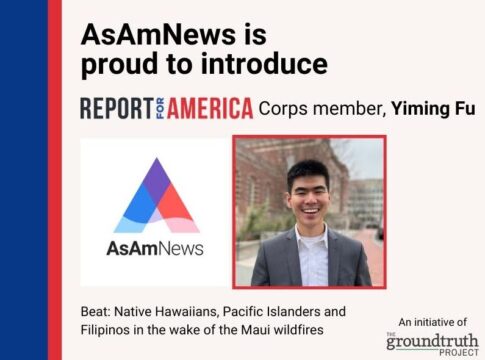By Julia Tong, AsAmNews Intern
A new study has revealed critical insights into how various Asian American subgroups approach misinformation and politics.
The study was conducted by the AAPI Victory Alliance, a group dedicated to building the political power of Asian Americans through education and advocacy.
The study, which focused on swing voters who were more targeted and impacted by media misinformation, revealed some broad trends. Those voters tend to be wary of engaging with politics, and do not actively seek out news by themselves. Many believe that all media is biased, especially English news sources, and have difficulty determining what is true or not.
Thus, those voters tended to be more affected by misinformation, as they were more likely to be influenced by facts which had already been debunked by major news sources. For instance, during the 2020 Presidential Elections, some participant found reports of double counted ballots, trashed voting machines, and other widely spread misinformation about the legitimately of the election potentially credible.
LATEST STORIES
Nisha Jain, senior Vice President of political research firm GBAO Strategies, said this type of misinformation could have serious impacts within the AAPI community.
“Increased concerns about voter fraud can then increase support for policies that… actually would impact [and] suppress voting in the AAPI community as well,” Jain said. “So I think this is something that is quite concerning.”
In March, the Alliance gathered a group of AAPI academics, philanthropists, and thinkers, launching the first AAPI think tank in the nation. It aims to ensure that data about Asian Americans is disaggregated, and policies benefiting AAPIs are proposed and advocated for in Congress.
As the group discussed what it should study for its first project, many participants across the board voiced concerns about mis- and disinformation within AAPI communities. Further, with a number of important elections upcoming, the group felt that a deeper understanding of how Asian Americans approached misinformation and news was especially relevant.
“You really can’t get to the substance of health care, of immigration, of voting rights if you can’t get the right information out there, and if people are not able to discern between truth and fiction,” Elizabeth Grossman, senior advisor to the AAPI Victory Alliance, said. “Finding this common theme across many different disciplines really led us to [think]—this really has to be our first project.”
Mis- and disinformation are a widely studied topic. However, little attention has been paid to how it affects AAPI communities in particular—especially the numerous ethnicities under the AAPI umbrella.
Accordingly, the study’s design rotated around examining specific groups within the AAPI umbrella. Researchers chose Texas, a large state with many AAPI ethnic groups and a contentious political environment, as the study’s location. They interviewed six total focus groups, featuring Chinese, Indian, Filipino, Vietnamese, and Korean Americans, as well as young Asian Americans under the age of 30. Finally, they provided sessions in the ethnic groups’ native languages, as well as moderators matching the ethnicity of participants, so participants felt comfortable and free to speak.
“It’s very rare to see disaggregated data on AAPI’s. So we wanted to not just look at API’s as a whole,” Grossman said. “We wanted to be able to say, well, what [about] the Vietnamese American community, what are what are they talking about? Where are they thinking? Where they getting their information? How about the Filipino American [population]?”
Voters also shared similar concerns about key political issues, such as economics, public safety, education, and gun control. A core issue Jain identified was inflation, and fears that wages were not rising commensurate to prices. Public safety and crime was another major concern, especially for women feeling unsafe due to anti-Asian racism. Across the board, many voters felt that both parties were untrustworthy, believing they were power hungry, corrupt, or overly influenced by lobbyists.

However, looking more closely at these broad trends revealed critical differences within each subgroup studied. Indian American participants were particularly concerned about the impact of education on their families. They also tended to be the most open towards claims about a stolen election. Non-English dominant Vietnamese and Chinese participants were susceptible to misinformation that African Americans were responsible for anti-Asian violence. Several Chinese and Viet participants expressed their desire for further investment in the police force as well. Filipino Americans spoke especially passionately against the impacts and forces responsible for anti-Asian racism.
Another critical difference was also younger versus older Asian Americans. Young people were more likely to identify misinformation. For instance, during the 2020 election, they focused more on voter suppression than voter fraud. Furthermore, though they shared similar concerns around the economy as the elder cohort, they saw different ways to improve economic policy: raising the minimum wage, lessening the cost of healthcare, forgiving student loans, lowering unemployment rate.
Young people, however, were also uniquely able to help their parents differentiate between misinformation and fact. The study notes that many young participants, especially from East Asian backgrounds, came from “politically mixed families.” While some from especially polarized families felt unable to speak up, others directly engaged their parents around those issues.
During the election, for instance, one young voter frequently challenged their mother to find reliable news sources. “When first she would express what she saw…I would ask her. I’m like, ‘Hey, where’d you get this information? Are you just aligning with this because of this reason?”
Some parents, too, were more trusting of news sent by their children. “If [my children] send me [news], I do less of a filter,” one Vietnamese participant said. “I trust them 70%.”
Finally, trusted media sources varied across ethnic groups. Each group’s approach to social media, for instance, varied considerably. Mandarin speakers tended to trust WeChat, receiving a wide diversity of news from chats on the platform. However, Indian Americans were distrustful of WhatsApp, and Korean Americans viewed KakaoTalk as a source of opinion and chat rather than news. Older people tended to rely more on Facebook, while younger people used Twitter and TikTok.
However, there was one striking trend: across age and ethnicity, many used YouTube as a source of information. This fact, however, may reflect the diversity within Asian American media interactions. Many immigrants, such as Korean, Chinese, and Filipino Americans, trusted mainstream news in their own language more than English groups. For them, YouTube is a vital platform to find newscasts in their native languages.
To executive director Varun Nikore, however, the results indicated a crucial takeaway: a movement away from criticizing “ethnic” sources, such as WeChat or KakaoTalk, as the biggest source of misinformation.
“I would like to stress that the misinformation and disinformation that AAPIs are more apt to believe are actually occurring on non-ethnic mainstream channels,” he said.
Overall, the research has still not been completed. The focus group study is the first part of a planned two-part study digging deeper into the topic. It was quantitative, rather than qualitative, and focused on a limited and small group of Asian Americans.
“We’ve only peeled back one layer of the onion here,” Nikore said. “This is, in many respects, infrastructure building on the thinking of AAPI communities, broken out by several, but not a large number of sub-ethnicities. The five that we had focused on certainly are well represented…but by no means do they speak for the entire AAPI community. And thus, further disaggregation of data and future research is going to need to be done.”
Grossman hopes that the second part of the study, which will be more quantitatively oriented, will not only shed more light on misinformation in AAPI communities, but cement the importance of their work in the broader consciousness.
“One of our hopes for this study is that we’re really going to show people that this is a population that should be paid attention to. Not just among AAPI activist groups like this one, but among people studying misinformation,” she said.
“There’s different nuances when you get into different groups, even if the problem…spans the whole nation. But there’s differentiation that is important and valuable as we’re looking to address missing disinformation.”
Read the full report from the Asian American Victory Alliance here.
AsAmNews has Asian America in its heart. We’re an all-volunteer effort of dedicated staff and interns. Check out our new Instagram account. Go to our Twitter feed and Facebook page for more content. Please consider interning, joining our staff, or submitting a story, or making a financial contribution.








